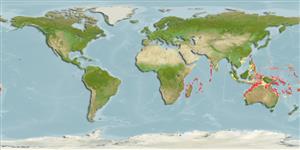Classification / Names
Common names from other countries
Main reference
Size / Weight / Age
Max length : 150 cm TL male/unsexed; (Ref. 4787); max. published weight: 50.0 kg (Ref. 4787)
Environment
Marine; reef-associated; depth range 50 - 300 m (Ref. 4319)
Climate / Range
Tropical, preferred ?; 21°N - 32°S, 30°E - 179°W (Ref. 5222)
Distribution
Indo-West Pacific: Natal coast of South Africa, northern Mozambique, Reunion, Mauritius, New Caledonia, Philippines, New Guinea, New Ireland, and Fiji. Recently recorded from Tonga (Ref. 53797). Unknown in the Red Sea and Persian Gulf.
Countries | FAO areas | Ecosystems | Occurrences | Introductions
Short description
Dorsal
spines
(total): 11;
Dorsal
soft rays
(total): 14-15;
Anal
spines: 3;
Anal
soft rays: 8. Distinguished by the following characteristics: pale brown body color with small dark brown to greyish green spots unevenly scattered on the dorsolateral parts of the head and body, dorsal and caudal fin; one row of close-set spots running posteriorly from the eye in a distinct line; absence of spots on the body below the level of the pectoral fins or on the anal and paired fins; body depth contained 2.7-3.2 times in SL; head length 2.2-2.4 times in SL; flat to convex interorbital area, dorsal head profile almost straight; angular preopercle, 2-4 distinctly enlarged serrae at angle; slightly convex upper edge of operculum; posterior nostril not much larger than anterior nostril; maxilla reaches below rear half of eye, ventral edge with low step at the distal expansion; 2 rows of teeth on midlateral part of lower jaw, inner teeth larger than outer teeth (Ref. 89707).
IUCN Red List Status (Ref. 115185)
Threat to humans
Harmless
Human uses
Fisheries: commercial
More information
ReferencesAquacultureAquaculture profileStrainsGeneticsAllele frequenciesHeritabilityDiseasesProcessingMass conversion
Tools
Special reports
Download XML
Internet sources
Estimates of some properties based on models
Phylogenetic diversity index
PD50 = 0.5000 many relatives (e.g. carps) 0.5 - 2.0 few relatives (e.g. lungfishes)
Trophic Level
4.1 ±0.7 se; Based on size and trophs of closest relatives
Resilience
Low, minimum population doubling time 4.5 - 14 years (tmax=11; Fec=46,769)
Vulnerability
Moderate to high vulnerability (53 of 100)
Price category
